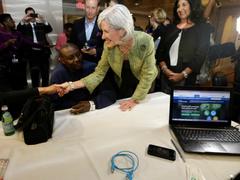 Youth Enrollment In Obamacare Lower Than Expected So Far
Youth Enrollment In Obamacare Lower Than Expected So FarHeadlines
Health
Nation
Politics
Obamacare Youth Enrollment
A new administration report shows youth enrollment in Obamacare has been lower than expected thus far.
Before the Affordable Care Act’s (ACA) October 1 rollout, officials hoped that 38% of enrollees would be between ages 18-35. Young people comprise a critical component of the ACA if the reform is to be successful. Since health insurance companies are no longer allowed to gouge older, less healthy people with high premiums, the ACA depends on young and healthy people to balance out premium costs.
Data in the report shows that 24% -- or 2.2 million -- of early ACA enrollees are in the 18-35-year-old age range.
But even with early numbers lower than desired, officials aren’t panicking. They note that the enrollment period for the bill runs through March, and accordingly they expect a large wave of young Americans to come forward and purchase insurance policies closer to this deadline.
“We are confident, based on the results we have now, that we'll have an appropriate mix of individuals enrolled in coverage," said Mike Hash, health reform director at the U.S. Department of Health and Human Services.
A report from the nonpartisan Kaiser Family Foundation reports that a sustainable marketplace could take hold even with only 25% youth enrollment.
The report says “that even if you only have 25 percent of your marketplace, of your composition being 18 to 34, that essentially takes death spiral off the table, that essentially you have a sustainable marketplace and that premiums would only be affected by a couple of percentages per person.”
Even with the dreaded marketplace “death spiral” avoided, officials obviously still hope to achieve their original goals. It should also be noted that young Americans under the age of 26 are eligible to be covered under their parents insurance policies.
The same report also shows that the majority of sign-ups are opting for the “silver” level plans. Silver plans cover an estimated 70% of a person’s health costs. As you may have guessed, silver plans are cheaper than gold and platinum plans and more expensive than bronze plans. Bronze plans offer a smaller network of doctors and include higher co-pays. Sources: Yahoo!, Politico, Healthcare.gov
1 Reported by Opposing Views 3 hours ago.
 If you've resolved to spend less and save more this year, you might consider investing in a good pair of running shoes.
If you've resolved to spend less and save more this year, you might consider investing in a good pair of running shoes. One night after debuting his new commercial for the company that plans to get HealthCare.gov's "shit unfucked," *Jimmy Kimmel* was back with a pair of ads that take on another Obamacare problem: getting young people to sign up. Instead of going to Spring Breakers route like The Daily Show, Kimmel went the other direction, showing an older couple explaining to those "young invincibles" just what they're paying for with their health insurance premiums.
Reported by Mediaite 4 hours ago.
One night after debuting his new commercial for the company that plans to get HealthCare.gov's "shit unfucked," *Jimmy Kimmel* was back with a pair of ads that take on another Obamacare problem: getting young people to sign up. Instead of going to Spring Breakers route like The Daily Show, Kimmel went the other direction, showing an older couple explaining to those "young invincibles" just what they're paying for with their health insurance premiums.
Reported by Mediaite 4 hours ago.
 Writing in USA Today, Daniel Garza, executive director of the conservative-leaning LIBRE Initiative, tore into the Obama Administration over the handling of ObamaCare, especially as it pertains to Hispanic outreach. Not only was the launch "two months late," Garza writes, "The The finished product turned out to be more punchline than health care portal."
Writing in USA Today, Daniel Garza, executive director of the conservative-leaning LIBRE Initiative, tore into the Obama Administration over the handling of ObamaCare, especially as it pertains to Hispanic outreach. Not only was the launch "two months late," Garza writes, "The The finished product turned out to be more punchline than health care portal."







